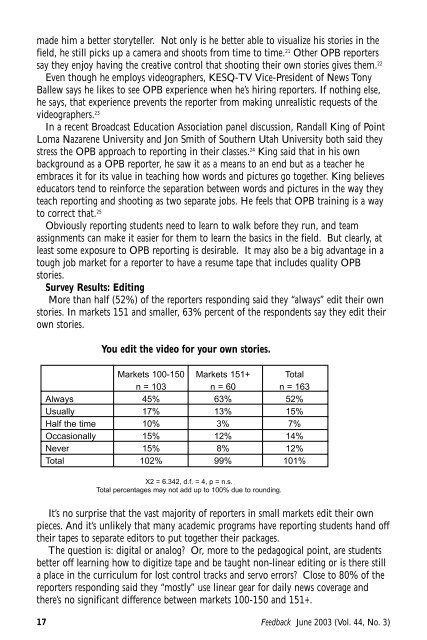JUNEFeedback
Issue 3 - Broadcast Education Association
Issue 3 - Broadcast Education Association
You also want an ePaper? Increase the reach of your titles
YUMPU automatically turns print PDFs into web optimized ePapers that Google loves.
made him a better storyteller. Not only is he better able to visualize his stories in thefield, he still picks up a camera and shoots from time to time. 21 Other OPB reporterssay they enjoy having the creative control that shooting their own stories gives them. 22Even though he employs videographers, KESQ-TV Vice-President of News TonyBallew says he likes to see OPB experience when he’s hiring reporters. If nothing else,he says, that experience prevents the reporter from making unrealistic requests of thevideographers. 23In a recent Broadcast Education Association panel discussion, Randall King of PointLoma Nazarene University and Jon Smith of Southern Utah University both said theystress the OPB approach to reporting in their classes. 24 King said that in his ownbackground as a OPB reporter, he saw it as a means to an end but as a teacher heembraces it for its value in teaching how words and pictures go together. King believeseducators tend to reinforce the separation between words and pictures in the way theyteach reporting and shooting as two separate jobs. He feels that OPB training is a wayto correct that. 25Obviously reporting students need to learn to walk before they run, and teamassignments can make it easier for them to learn the basics in the field. But clearly, atleast some exposure to OPB reporting is desirable. It may also be a big advantage in atough job market for a reporter to have a resume tape that includes quality OPBstories.Survey Results: EditingMore than half (52%) of the reporters responding said they “always” edit their ownstories. In markets 151 and smaller, 63% percent of the respondents say they edit theirown stories.You edit the video for your own stories.Markets 100-150 Markets 151+ Totaln = 103 n = 60 n = 163Always 45% 63% 52%Usually 17% 13% 15%Half the time 10% 3% 7%Occasionally 15% 12% 14%Never 15% 8% 12%Total 102% 99% 101%X2 = 6.342, d.f. = 4, p = n.s.Total percentages may not add up to 100% due to rounding.It’s no surprise that the vast majority of reporters in small markets edit their ownpieces. And it’s unlikely that many academic programs have reporting students hand offtheir tapes to separate editors to put together their packages.The question is: digital or analog? Or, more to the pedagogical point, are studentsbetter off learning how to digitize tape and be taught non-linear editing or is there stilla place in the curriculum for lost control tracks and servo errors? Close to 80% of thereporters responding said they “mostly” use linear gear for daily news coverage andthere’s no significant difference between markets 100-150 and 151+.17Feedback June 2003 (Vol. 44, No. 3)
















